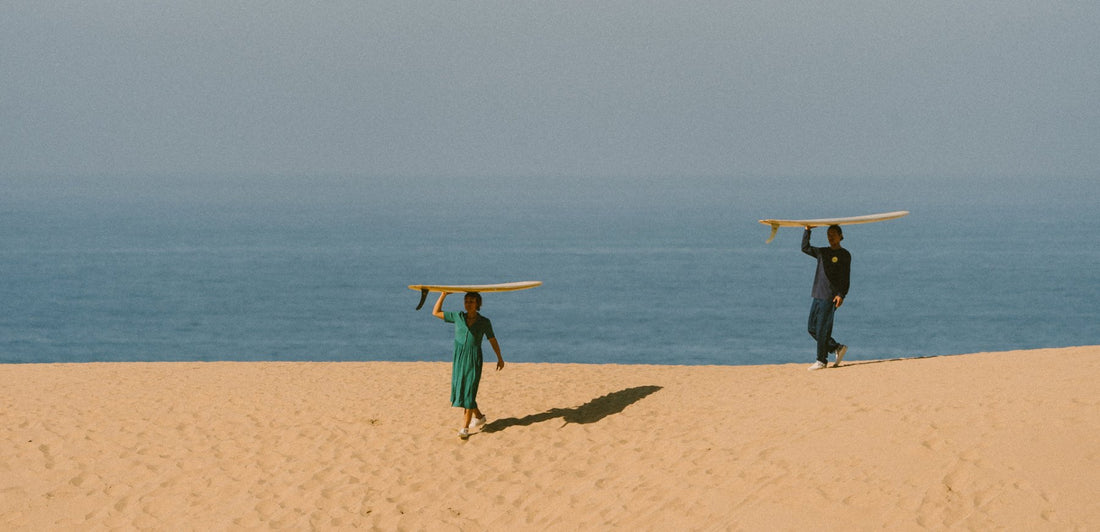Morocco and Imsouane are particularly dear to everyone’s hearts here at TWOTHIRDS. We’ve surfed there. We’ve absorbed the region’s rich culture. We’ve even held a fashion shoot on its beguiling coastline. It was therefore heart wrenching to read the news which broke in January that demolition works had begun, razing local residences and small-scale businesses to make way for a luxury complex, all under the guise of sustainable development.
Credit: @meftah_abdell
“We’ve surfed there. We’ve absorbed the region’s rich culture. We’ve even held a fashion shoot on its beguiling coastline.”
The reasons given by Moroccan authorities, for what appeared to be a sudden and drastic move, were that all the demolished properties were built illegally, without permits; on private land. The houses and businesses – many of which had existed for decades – were therefore deemed expendable.
Whatever the strength of the justifications for this demolition, what’s clear is that this quaint and unique surf paradise will never be the same again, leaving questions about what sustainability really means, and how using it as an excuse to bring about gentrification could be a serious red flag for surf enthusiasts and beach lovers everywhere.

The Argument FOR New Development
At first glance, it appears that there are two valid counterarguments at play in Imsouane, one which is broadly against the new development and one that is for it. Talking to Surfline, a local who wished to remain anonymous said that many of the buildings destroyed were “built on land that doesn’t belong to them,” and that some “illegal cottages rented out to tourists are not connected to the sewage system” leading to water pollution issues.
For sustainability reasons, as well as health and safety factors, it was obvious that the dwellings and businesses that dotted Imsouane’s La Cathédrale area needed to be upgraded. The problem is that this is seemingly being achieved at the expense of relatively poor, powerless locals. People who were once owners of their own small businesses are now either going to be forced into wage labour at the new development or will have to leave Imsouane indefinitely, which begs the question: Who is this strain of sustainability really benefiting?

The Argument AGAINST Development
The most pertinent question that must be asked is: Was environmental concern the true motive for development of the area? Surely updating the sewage systems of the pre-existing buildings would have been a more humane option, so that the cultural heritage of the area could be maintained and locals might continue their lives as normal.
Unfortunately, as Ben Mondy of The Inertia points out, there may be people high up in the Moroccan government who are invested in projects similar to the one mooted for Imsouane, having overseen the gentrification of other stretches of Moroccan coastline, albeit with varying degrees of financial success (many new luxury hotels in the region are often close to empty).
Another important question is whether the new development will genuinely be more sustainable than what came before it? Mooted to be a luxury resort, studies have shown that the higher star-rating a hotel boasts, the larger its water impact. The same is true of emissions.
Even putting aside water use, habitat pollution and emissions, proponents of modern developments such as this seem intent on erasing the social justice elements that feature in most sustainability definitions. It is hard, for example, to envision that the new development in Imsouane is in accordance with UN SDGs 1, 3, 8, 10, 11 or 16, especially when the reader considers that residents were given a few short hours to leave their properties and relocate.
“There is also the question of whether the new development will actually be more sustainable than what came before it?”
Sustainability & Surfing Risk Being Seen As Oppressive & Elitist

Events in Imsouane are the latest in a worrying trend, whereby indigenous working people bear the brunt of the costs involved with sustainability initiatives and transitions, many of which people rightly identify as smokescreens for schemes designed to make already wealthy people even richer.
Nowhere is this issue more prevalent than at popular surf destinations, where local communities that have lived harmoniously with nature for generations are pitted against outside investors, who insert themselves into a region under the guise of sustainable development, the benefits of which are rarely felt by local residents and the environment. Perhaps world longboard champion Joel Tudor put it best in Stab Magazine when talking about the recent gentrification of another Moroccan surf paradise, Tifnit:
“All you kooks with your yoga retreats, surf camps and online magazines have blown this place (Tifnit) up… I hope you’re happy now… y’all just namaste’d it into rubble, soon to be high-end rentals.”

What is TWOTHIRDS Doing to Stop Coastal Gentrification?
With Tudor’s rage still ringing in our ears, we have to ask ourselves: Are we part of the problem? Afterall, we were one of the brands that glorified Imsouane as a destination, which may in part have led developers to believe that surf culture could be a vehicle for profit-driven gentrification. While it’s true that some of the people who have been dispossessed in Imsouane relied on visitors like our shooting team for their livelihood, that is scant consolation for them now they are left with nothing.
What have we learnt from this sad chapter? The best way to be sustainable is to keep things local. For this reason, we will endeavour to keep our in-house fashion shoots as local as possible, in Spain or countries like neighbouring France and Portugal. That way we can support local ocean communities, while helping maintain a balance in those further afield. We would encourage our ocean community to shun luxury resorts and soulless rental accommodation, to instead support small businesses that value social cohesion and priceless cultural heritage.












